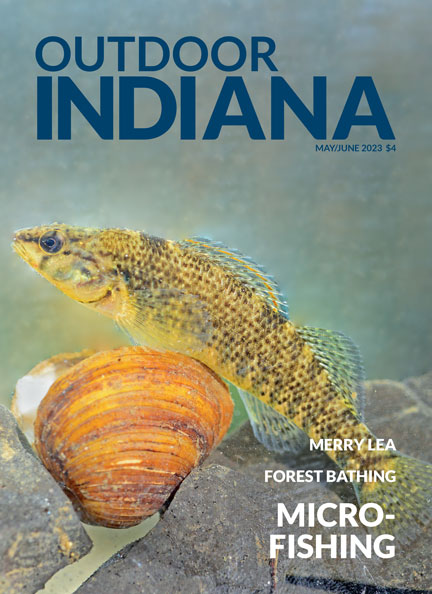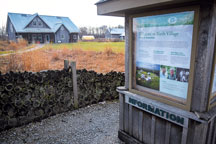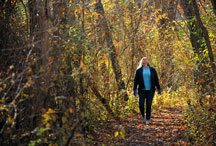About Outdoor Indiana
Outdoor Indiana, the state's premier magazine, delivers the wonders of the Hoosier outdoors to subscribers' homes and offices six times a year in 48 pages of vibrant color. For the best of state parks, lakes, wildlife, forests, trails, hunting, fishing, wildflowers and outdoorsy people, plus inside information from DNR experts, subscribe for $15 per year or $28 for two years. Follow the magazine staff on Facebook.

A female rainbow darter, a target of microfishers, hovers atop the shell of a dead, non-native Corbicula fluminea, which typically measures about 3/4 of an inch across. Photo by John Maxwell
Featured Stories
- From the director
CONNECTING US WITH TRAILS

DNR Director Dan Bortner
Across Indiana, trails connect us. Whether they’re linking us to our favorite park, a neighboring community, or points beyond, trails provide an outstanding resource to get us moving and help us explore more of our Hoosier treasures.
As trails fans, we cheered in late 2018 when Governor Eric Holcomb announced his Next Level Trails initiative—a transformational plan to lead the state’s largest-ever investment into our trails network. Four and a half years later, we’ve announced $150 million in Next Level Trails investments and have already helped build more than 50 new miles statewide.
That work has earned the governor and our state a national accolade: Rail-Trail Champion.
Earlier this year, Gov. Holcomb shared more Next Level Trails news in his State of the State Address, announcing that the state’s longest contiguous recreational trail will be built in southern Indiana.Known as the Monon South Trail, this trail will run 62.3 miles through five counties and eight communities, following the route of the historic Monon Railroad. The passageway will eventually connect New Albany in the south to Mitchell in the north.
In the photo above, our DNR team joins partners with the City of New Albany and Radius Indiana—the groups that will oversee the trail—to officially close on the property.
With Monon South and our many other trails, we’re proud to preserve Hoosier history and pave new trails into our future.What’s your favorite trail? Find one near you at on.IN.gov/trailfinder.
- A TINY FISH TALE
Seeking, catching, and releasing fish other anglers can barely see
By Scott Roberts, OI staff
Photography by John Maxwell
Ron Anderson nets a Northern studfish while microfishing Sugar Creek last June with Jarrett Maurer. The Bloomington anglers seek and learn about many wild fish species most sportfish anglers overlook.
Ron Anderson and Jarrett Maurer admit they’ve gotten strange looks when practicing their craft.
“We’ve fished in roadside ditches with just a few inches of water, in people’s front yards, with their permission—just about anywhere water can pool, we’ve stuck in a line,” Anderson said. “We always get the same comment: ‘There aren’t any fish in there.’”
The onlookers are correct—in terms of sportfish. Bass, walleye, bluegill, and crappie aren’t found in roadside ditches or puddles. But that’s not what this Bloomington duo goes after. They’re looking for tiny, hard-to-find species that many times can only be found in out-of-the-way places. They’ve caught their share of common sportfish throughout their years of angling and moved on to pursue what they consider the more exotic and interesting fish of Indiana and the rest of the Midwest.
Their sport, called microfishing, is, as the name suggests, about catching tiny fish. Many of these fish can be found in only a few places, and only at specific times of year, which is why microfishers occasionally venture to nontraditional fishing spots.
No standard classification deems a fish a microfish, but aptly named DNR nongame aquatic biologist Brant Fisher says about half of Indiana’s 200 different species meet most standard definitions. Most Hoosier anglers target only about 25 species, all sportfish.
To read the rest of this article subscribe to Outdoor Indiana or pick up a copy at one of our state park inns. To subscribe, click here or call (317) 233-3046.
- GRAVEL HUNT YIELDS ‘HAPPY MEADOW’
Merry Lea in Goshen doubles as nature destination and learning center
By Phil Bloom
Rieth Village, a platinum Leadership in Energy and Environmental Design (LEED) certified site as an example of best practices in sustainable design, features two cottages for undergraduate summer housing as well as a classroom and office.
As a young civil engineering graduate of Purdue University, Lee Rieth was sent on a scouting mission to find gravel deposits to use to resurface State Road 109 north of Columbia City.
When he came across an area near Wolf Lake in Noble County, he crossed it off his list of possibilities. Not because it lacked the target materials but because, as Bill Minter tells it years later, Rieth saw something different in the landscape.
“He said, ‘We need to leave this alone and not exploit it,’” said Minter, the director of land management at Merry Lea Environmental Learning Center. “Even though he was an engineer and developer, he had a sensitivity that there are special places.”
Rieth, who later helped lead the family-owned road construction company Rieth-Riley, and his wife, Mary Jane, took a first step toward protecting the area in 1964 when they purchased a 40-acre parcel near Bear Lake. A year later they named it Merry Lea, meaning “happy meadow”. To support their vision, they established the Merry Lea Nature and Religious Foundation.
These actions set the stage for the couple’s goal of fostering environmental education in a natural setting.
That idea has evolved into a nearly 1,200-acre gem owned by Goshen College. Its mission is to provide:
- A natural sanctuary for northern Indiana’s plants and animals.
- Environmental education for people of all ages.
- A setting that fosters activities “to benefit the human body and spirit” without exploiting the natural resources.
From that small beginning, today’s Merry Lea complex includes lakes, wetlands, upland and lowland forests, oak woodlands and savannas, prairies and meadows, and landscape remnants of glaciers that shaped northern Indiana eons ago. About half the area is reachable on 8 miles of hiking trails that are open to the public from dawn to dusk.
To read the rest of this article subscribe to Outdoor Indiana or pick up a copy at one of our state park inns. To subscribe, click here or call (317) 233-3046.
- STRESSED OUT? GO ‘BATHE’ IN THE FOREST
STRESSED OUT? GO ‘BATHE’ IN THE FOREST
Just doing nothing, in nature, has documented health benefits
By Nick Werner
Cristin Bragg focuses on silence and slow movement while hiking a trail during a sensory walk at Salamonie Lake.
On the last Saturday in October 2022, Cristin Bragg followed a guide into the woods.
She expected a hike, but what she got was more of a meditation. The guide asked Bragg and a handful of others to be silent and look around, then invited them to sit on the ground and breathe deeply.
“Feel the ground,” the guide said. “Feel the wind. Feel the heat from the sun.”
At first, this communal experience with Mother Nature felt anything but natural to Bragg. Slowing down and surrendering to your senses can seem foreign to people like her who lead fast-paced lives.
‘I’m taking a Saturday morning where I could get a lot done and I’m just going to stand in the forest?’ Bragg remembers thinking to herself.
But before long her day-to-day worries were replaced with mindful observations—a flying bug’s path influenced by a slight breeze, a bright red leaf in a pile of dull brown ones, a maple tree and an oak tree whose branches had become intertwined.
She felt at home in the woods and at peace in her mind.
To read the rest of this article subscribe to Outdoor Indiana or pick up a copy at one of our state park inns. To subscribe, click here or call (317) 233-3046.
Reader Photos
Each issue, Outdoor Indiana staff will select reader submitted photos to feature in the magazine. If you would like the chance to be featured, please submit your photo, along with your name and phone number to:
Please, only submit original photography that you have taken. Do not send files over 9 MB in size. JPG format is preferred.
Subscribe to Outdoor Indiana magazine
Visit the Indiana State Parks online store to subscribe. Cost is $15 for a one year subscription (6 issues) or $28 for two years (12 issues).
Donate
Printing and distribution costs for Outdoor Indiana magazine have increased. One way we’re offsetting these costs is through the Friends of Outdoor Indiana Group administered through the Indiana Natural Resources Foundation. Donations to our friends group helps keep our subscription price low and ensures we’ll be around to bring you the best of Indiana’s outdoors for years to come. Donate at the INRF website and include “Friends of Outdoor Indiana” in the “In Honor Of/In Memory Of” line.
Outdoor Indiana
402 W. Washington St., W255-B
Indianapolis, IN 46204
317-233-3046
OIorders@dnr.IN.gov

